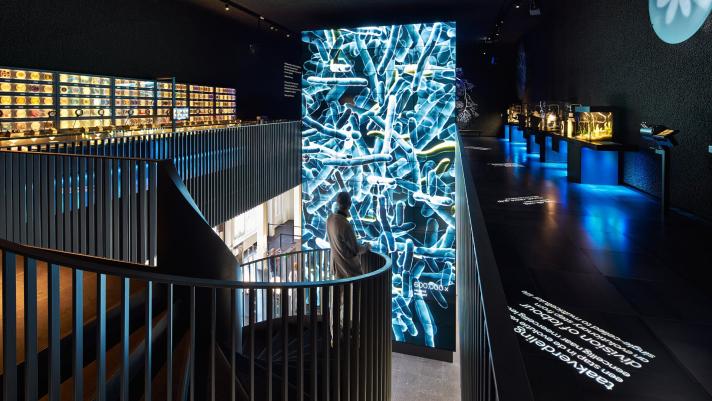
In the scope of increasing awareness and acceptance of algae, we spoke with marine biologist, entrepreneur, and Head of ARTIS-Micropia museum, Thomas Swierts. He shared his journey and insights on joining the world's only microbe museum. Keep reading to learn what he had to say, and what he shared with us about his experiences and predictions about the future of the algae industry.
1. Can you share a bit about your background, from being a marine biologist to becoming an entrepreneur and Head of ARTIS-Micropia museum? How did your journey inspire you to be where you are today?
I was born and raised in Amsterdam and decided to study Biology at the University of Amsterdam. This was mostly because I was drawn to the popular and famous flagship species of nature. I wanted to learn about primate behaviour, coral reefs, and tropical rainforest ecology. However, during my studies, I realised that microbes are at the core of all natural processes. The first life on Earth were microbes, cyanobacteria created the oxygen in our atmosphere, and for every human cell in our body, we also harbour a microbe. Many ocean processes (and consequently also the atmospheric ones) are driven by microscopic algae.
2. As a marine biologist, Head of ARTIS-Micropia museum, and entrepreneur, how do you balance distributing information and conducting research? What challenges do you usually face, and how do you address them?
ARTIS-Micropia is located in Amsterdam and is part of ARTIS Amsterdam Royal Zoo. It is the only microbe museum in the world. As such, we get specialists in microbiology from all over the world to visit our museum. We also aim to reach people without a specific microbiology background, especially children, to hopefully inspire them to consider a career in microbiology. It is challenging to create content for a museum that caters to all these levels of knowledge and experience. We always try to incorporate multiple levels of information in our exhibits and programmes so everyone can learn something new.
Additionally, people usually associate microbes with disease or filth, often wrongly so. For example, blue-green algae, which are actually not algae, are mostly known in the Netherlands for causing harmful blooms in lakes. However, both cyanobacteria and algae are incredibly beneficial organisms, supporting our existence and offering numerous applications. At Micropia, we strive to show micro-organisms as they are: an integral part of nature, and even of ourselves.
3. Tell us about your involvement in the ARTIS-Micropia museum. How did it start, and what sparked your interest and resonated with you?
In early 2023, the position of Head of ARTIS-Micropia became available. The combination of science, education, art, and design at the museum was very appealing to me. The role requires me to think from educational, creative, and commercial perspectives, and find the right balance between different interests, which is a daily challenge that I enjoy very much. As a biologist born and raised in Amsterdam, I feel fortunate to be the Head of the only microbe museum in the world in my hometown.
4. From your perspective, how can an initiative such as the ARTIS-Micropia museum bridge the gap between scientific research information and public awareness, particularly in the algae industry?
ARTIS-Micropia offers a unique platform to bridge the gap between scientific research and public awareness. By presenting microorganisms in an engaging, accessible manner, Micropia can explain complex scientific concepts to the general public.
For algae in particular, ARTIS-Micropia can inform visitors about the critical role of algae in aquatic ecosystems and showcase the diverse applications of algae in industries such as biofuel, food production, pharmaceuticals, and environmental sustainability. By showing these applications Micropia can underscore the potential of algae as a sustainable resource.
Furthermore, ARTIS-Micropia also has many followers on online platforms, and can thus also inform people through these channels and not only people who visit the museum.
5. Considering the objectives and goals of ARTIS-Micropia museum, how do you see Micropia positively impacting the competitiveness of microalgal-based industries and enhancing the visibility and marketability of microalgal products across various industries?
For algae to become a more competitive industry, they must become more mainstream. ARTIS-Micropia can significantly enhance public awareness of algae’s properties and serve as a platform where various companies and industry stakeholders can come together to learn from each other and collaborate. By fostering these connections, we can help grow the industry as a whole to become more competitive against less sustainable alternatives.
6. As the Head of ARTIS-Micropia museum and a marine biologist, how do you envision the future impact of your work in shaping public perception and understanding of algae? Are there specific goals or directions you hope to see your contributions take in the continued development of the Micropia museum and the algae industry as a whole?
As the Head of ARTIS-Micropia, I would like to show people the positive side of microbes – their beauty and power – and show that microorganisms are our allies, providing us with all kinds of products that can help solve various problems. As a marine biologist, I have seen again and again how microorganisms, including algae, shape the marine world, and therefore the entire world. I hope our work at Micropia enhances public perception and understanding of algae by showcasing their crucial role in sustainability and innovation. Highlighting algae's benefits is a key goal, and hopefully, we can help the promotion and usage of algae-based solutions across various industries.
Additional information
Join the #EU4Algae conversation and don’t forget to keep an eye on the EU4Algae Forum to stay updated and learn more about the ongoing activities, initiatives and updates on the development of the EU4Algae Forum online.
To contact us, please use the following email: contact eu4algae [dot] eu (contact[at]eu4algae[dot]eu).
eu4algae [dot] eu (contact[at]eu4algae[dot]eu).
Details
- Publication date
- 10 July 2024
- Author
- Directorate-General for Maritime Affairs and Fisheries




